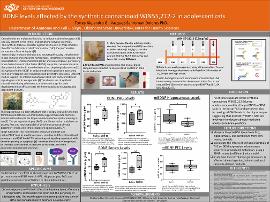| dc.contributor.author | Torres, Alejandro | |
| dc.contributor.author | Vazquez-Sanroman, Dolores | |
| dc.date.accessioned | 2023-11-02T20:44:10Z | |
| dc.date.available | 2023-11-02T20:44:10Z | |
| dc.date.issued | 2023-02-17 | |
| dc.identifier | ouhd_Torres_bdnflevelsaffectedby_2023 | |
| dc.identifier.citation | Torres, A., and Vazquez-Sanroman, D. (2023, February 17). BDNF levels affected by the synthetic cannabinoid WIN55,212-2 in adolescent rats. Poster presented at Research Week, Oklahoma State University Center for Health Sciences, Tulsa, Ok. | |
| dc.identifier.uri | https://hdl.handle.net/11244/339880 | |
| dc.description.abstract | Cannabinoids are molecules that bind to endocannabinoid receptors (eCBRs) CB1 and CB2 present in the central and peripheral nervous system. The synthetic CB1 receptor agonist WIN55,212-2 (WIN) emulates the effects of delta-9-tetrahydrocannabinol (THC), the psychoactive component of cannabis. Interestingly, endocannabinoids and neurotrophins, play critical roles in mood, immune and endocrine homeostasis, stress/anxiety response, and neuroplasticity. Endocannabinoids (eCBs) and neurotrophins, particularly brain derived neurotrophic factor (BDNF), are potent neuromodulators that play critical roles in many behavioral and physiological processes. Disruption of either BDNF or endocannabinoid signaling is associated with an overlapping set of neurologic and psychiatric diseases. The chronic use of synthetic cannabinoids during adolescence, a vulnerable stage for brain development may affect or alter the homeostasis and neuroplasticity dependent on BDNF. Therefore, we evaluated the effect of adolescent exposure to WIN on blood and brain [periaqueductal gray (PAG), prefrontal cortex (PFC), hippocampus, and cerebellum] concentration levels of BDNF. | |
| dc.description.abstract | Methods: adolescent rats received 5 twice-daily injections of saline (1 mL/kg i.p.) or WIN55,212-2 (0.8 mg/kg i.p.) every other day. Brains and truncal blood were collected, and ELISA immunoassay was used to determine pro and mature BDNF levels. | |
| dc.description.abstract | Results: One way ANOVA revealed that WIN increased proBDNF [F 1,11= 12.57, p<0.05] and mBDNF levels [F 1,11= 2.63, p<0.05] in the dorsolateral PAG and periphery [F 1,11= 5.15, p<0.05]. PFC, hippocampus, and cerebellum results are being processed. | |
| dc.description.abstract | Discussion: The chronic exposure of synthetic cannabinoid WIN during adolescence modifies the proBDNF/mBDNF ratio in the dorsal PAG and periphery, suggesting that proBDNF/mBDNF ratio are involved in endocannabinoid-mediated adolescence brain plasticity. | |
| dc.format | application/pdf | |
| dc.language | en_US | |
| dc.publisher | Oklahoma State University Center for Health Sciences | |
| dc.rights | The author(s) retain the copyright or have the right to deposit the item giving the Oklahoma State University Library a limited, non-exclusive right to share this material in its institutional repository. Contact Digital Resources and Discovery Services at lib-dls@okstate.edu or 405-744-9161 for the permission policy on the use, reproduction or distribution of this material. | |
| dc.title | BDNF levels affected by the synthetic cannabinoid WIN55,212-2 in adolescent rats | |
| osu.filename | ouhd_Torres_bdnflevelsaffectedby_2023.pdf | |
| dc.type.genre | Presentation | |
| dc.type.material | Text | |
| dc.subject.keywords | BDNF | |
| dc.subject.keywords | cannabis | |
| dc.subject.keywords | WIN55 | |
| dc.subject.keywords | adolescence | |
| dc.subject.keywords | hippocampus | |
